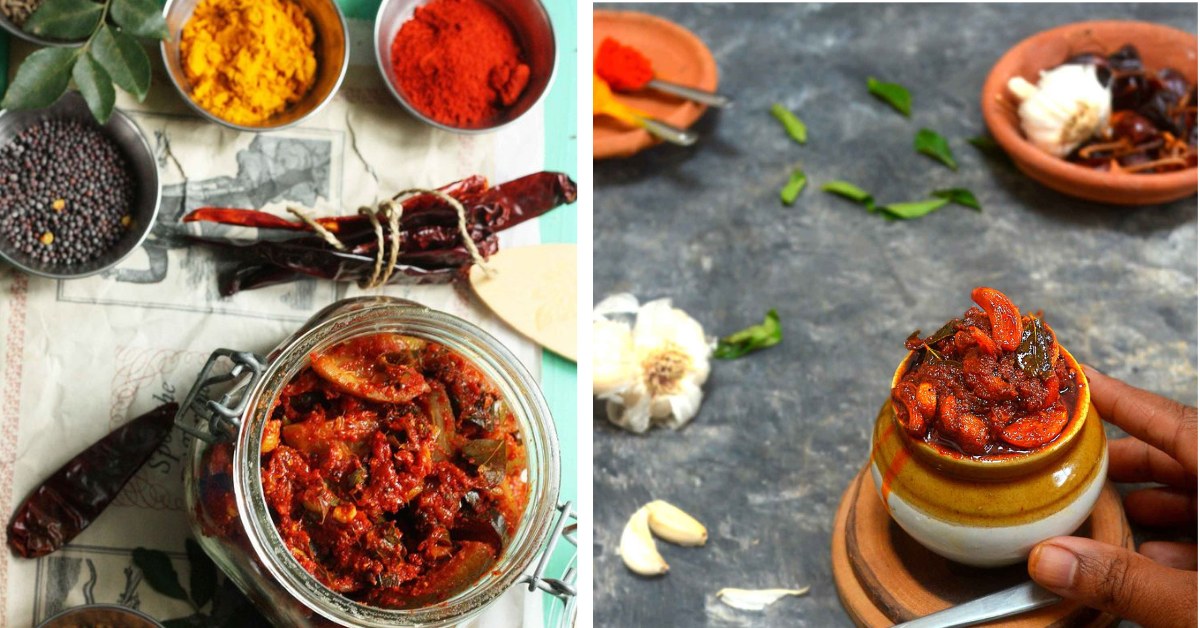When the Rains Arrive, So Do the Pickles: 5 Monsoon Recipes From Across India’s Kitchens
The rich, tangy aroma that wafts up when you open a pickle jar takes you straight back to your grandmother’s kitchen. The image of those tired, scalloped hands chopping lemons into thin, even slices with admirable precision; the crackle of mustard seeds, the sting of chilli in the air, the clink of glass jars on stone floors; all of it comes straight back.
In my home state, Kerala, the traditional monsoon pickles were stored in round ceramic jars, called bharanis. They were hidden, sometimes in shaded rooms or behind curtains, for it to ferment and also to save it from kids who just couldn’t wait to sneak a finger in for a taste. This little jar of happiness was another exciting ritual to wait for during the monsoons. The rains were nature’s nudge to start the fermenting season.
Today, when supermarkets stock every flavour year-round, these handmade jars remain mostly as fond memories instead of active practices — made with hands that knew how to listen to the weather, how to trust their gut, and how to feed yours. Here are a few monsoon recipes from across India.
 Traditional monsoon pickles are time-honoured recipes made using seasonal produce and natural fermentation, preserving the flavours of the rainy season in every bite. Image source : Pinterest, http://www.Worth2deal.com
Traditional monsoon pickles are time-honoured recipes made using seasonal produce and natural fermentation, preserving the flavours of the rainy season in every bite. Image source : Pinterest, http://www.Worth2deal.com
1. Bihar’s barish ka nimbu ka achaar — lemon & mustard pickle
What makes it special
In Mithila, fresh lemons appear in June. Families lay them out to dry after the first showers before steeping them in mustard seeds and green chillies. The result is a tangy-sour pickle that deepens with age — easily lasting a year.
How to make it
- Slice lemons, salt them lightly.
- Dry for two to three days in dappled sun.
- Add ground mustard seeds, green chillies, turmeric, and mustard oil.
- Let it mature for at least 20 days.
Pro tip: No sun? Wrap in a cotton towel and place near the stove. The gentle warmth drives fermentation.
2. Kerala’s kanni manga — the baby mango pickle
What makes it special
In Malabar, tiny marble-sized mangoes mark the beginning of monsoon pickling. Prepared by grandmothers with patience and precision, this salty and sour pickle captures childhood memories.
How to make it
- Wash and soak baby mangoes in brine for 15 days.
- Mix with mustard seeds, red chilli powder, fenugreek, and garlic in tempered coconut oil.
- Let it ferment for a few more days in a ceramic bharani.
Pro tip: Use rock salt and store it in a cool, dark place. Fermentation thrives in consistent humidity.
3. Nagaland’s bamboo shoot pickle — the wild, fermented wonder
What makes it special
In Northeast India, monsoons mean foraging for fresh bamboo shoots. These are fermented in natural spring water and stored underground or in leaf-wrapped bundles. The result? A strong-smelling, umami-rich delicacy served with rice and pork.
How to make it
- Get fresh or canned bamboo shoots (available online or in Northeast stores).
- Boil lightly, then mix with mustard oil, bhut jolokia (or any spicy chilli), garlic, and salt.
- Store in a jar for seven to 10 days to ferment.
Safety tip: Bamboo shoots can release cyanogenic compounds — always cook or boil before using.
Preservation tip: Use sterilised glass jars and wooden spoons to avoid spoilage.
4. Rajasthan’s baingan ka achaar — the forgotten eggplant pickle
What makes it special
In arid Rajasthan, eggplants are pickled during monsoon using mustard oil and asafoetida. Traditionally made by desert-dwellers to survive lean months, it’s tangy, smoky, and deeply umami.
How to make it
- Roast baby brinjals lightly and slit them.
- Fill with a spice mix of fennel, asafoetida, chilli powder, salt.
- Pour hot mustard oil and let rest for 10–15 days.
5. Karnataka’s maavina midi uppinakayi — tender mango pickle
What makes it special
In the lush Western Ghats and coastal regions of Karnataka, monsoon heralds the arrival of maavina midi — baby mangoes the size of a thumb. These are hand-picked before the rains get heavy, and pickled whole in a fiery, salty brine that lasts all year.
Traditionally made in large ceramic jars and stirred with long-handled wooden spoons (kopparige), this pickle is deeply nostalgic for Kannadigas — often eaten with ganji (rice gruel) on cold, rainy nights.
How to make it:
- Clean and dry tender mangoes without removing the stalk.
- Soak in strong brine for two to three weeks.
- Add a ground spice mix of dry red chillies, mustard seeds, turmeric, and asafoetida.
- Pour hot sesame oil over the top to seal it.
Shelf life: If made right, this pickle lasts over a year — and the flavour only gets better over time.
Edited by Khushi Arora
News